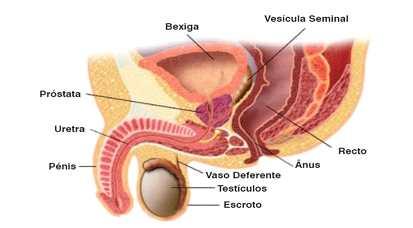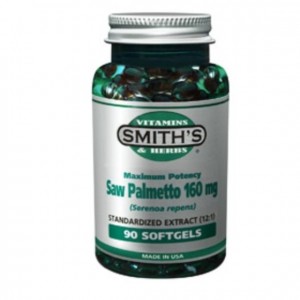Product Information
Saw Palmetto 160 mg 90 softgels (em gel capsules)
Saw Palmetto is an extract derived from the deep purple berries of saw palmetto palm tree (Serenoa repens). Saw Palmetto Serenoa repens is a plant of coastal regions of the southern United States and southern California.
Active Ingredients: Saw palmetto include fatty acids (Acid Caprice, caprylic acid, lauric acid, myristic acid, palmitic acid, stearic acid, oleic acid, linoleic acid and linolenic acid), plant sterols (campesterol, estigmasterol, beta-sitosterol, e cicloartenol ), essential oil, saponins esteroidais, compounds polyprenic, flavonoids, glucose, galactose, arabinose, urónico acid and other polysaccharides.
Saw palmetto is a plant that is most commonly used to treat problems associated with benign prostatic hyperplasia (BPH). Benign prostatic hyperplasia is a benign disease (noncancerous) where an excessive growth of prostate tissue pushes the urethra and bladder, blocking the flow of urine. Na BPH, the prostate grows and presses against the urethra and bladder, which interferes with the normal flow of urine. This leads to symptoms of urinary hesitancy, frequent urination, increased risk of urinary tract infections and urinary retention. Benign prostatic hypertrophy is triggered by abnormally high levels in male hormone testosterone and dihydrotestosterone (DHT), in prostate tissue. Saw palmetto inhibits the conversion of testosterone to dihydrotestosterone (DHT), by lowering the activity of 5-alpha-reductase. Saw palmetto inhibits further binding of DHT to nuclear receptors prostate. Saw Palmetto also inhibits prostaglandin synthesis and thus contributes to the anti-inflammatory effect and to reduce swelling in BPH and prostatitis. Saw palmetto can improve symptoms of benign prostatic hypertrophy, as the flow of urine and painful urination, and can reduce the number of times a night, that a man with this problem has to urinate. Saw palmetto has a slight anti-inflammatory action, anti-séptico, diuretic, and sedative properties. Saw palmetto has also been used to treat conditions of the respiratory tract, including coughs and colds, bronchitis and asthma. Saw palmetto is useful for urinary tract infection.
Recommended Use:
Take 2 capsule per day (1 morning and 1 night). Do not exceed the recommended dose. The minimum duration of the treatment is 6 weeks, but to maximize results, aconselha be 6 months.
This supplement should not be used as a substitute for a varied diet and a healthy lifestyle.
Keep out of reach of children.
Store at room temperature.
Liquid Weight: 40 g.
Serving Size: 1 cápsula / Amount per serving / % RDA
Calories / 4 Kcal / +
Calories from Fat / 4 Kcal / +
Total fat / 445 mg / 1% / +
Saw Palmetto Extract (12:01) (Serenoa repens berry)
padronizado para ácidos graxos and esteróis 85-95% / 160 mg / *
+ Based on a daily diet 2000 Kcal
* RDA not established
Other ingredients: olive oil, gelatin, glycerin
Contains: sem trigo, no milk or milk derivative, sem lactose, sugar, the hall, unpreserved, without artificial dyes, without artificial flavor.
Prostate – Size Matters
It is one of the most sensitive organs of the body, and much is due to its location.
Housed between the penis and the bladder and surrounding the urethra completely, the growth of this small gland from middle age may cause sexual and urinary problems.
As menstruation in women, é a “headache” that any man would dispense.
Learn to be prevented.
The prostate is a gland about the size of a walnut that is located in front of the rectum and just below the bladder, surrounding the urethra (channel ending in penis, where is conducted urine and semen to be expelled).

From the 30 years, the area of the prostate surrounding the urethra undergoes growth, that is designated Benign Prostate Hypertrophy – when the cell size increases – benign prostate hyperplasia e da – when the number of cells growing. The two terms are used interchangeably, It is more common to use the acronym BPH. As its name implies, it is a benign condition. BPH is not cancerous or leads to cancer.
Diagnosing a hidden problem
As the urethra passes through the prostate, it increases when the urethra is compressed, which causes difficulty in urinating. The table of symptoms developed by the American Urological Association (see table below) allows you to diagnose the severity of obstruction. Where the score is above 20, a doctor should be consulted, The severe obstruction can lead to bladder infection and kidney failure. According to the Portuguese Association of Urology (APU), near 20% Men 40 years, 50% two 60 years and 90% Over the 80 years have evidence of BPH. This does not mean that everyone has to enlarged prostate or have the characteristic symptoms of this disease. Statistically, sound search 50% microscopic evidence of men with BPH have symptoms that affect their quality of life. The diagnosis is made by rectal palpation, examination that most men fear, but that is indispensable for the early detection of nodules or tumors.

Pharmacological treatment of BPH
Some diseases can manifest with similar urinary symptoms caused by BPH. The APU identifies prostate carcinoma, chronic prostatitis, the grips of the urethra, inflammation and bladder tumors, some neurological diseases with bladder involvement – Sequel of cerebrovascular accidents, arteriosclerosecerebral, dementia, Parkinson's disease, hérnia discal, diabetes, etc.. Treatment with some drugs (antispasmódicos, bronchodilator, nasal decongestants, antidepressants) can also cause or worsen some of the symptoms.
Among the various forms of treatment for BPH, destacam up the following:
1 – Periodic surveillance and adoption of certain lifestyle habits that release compression prostate: not being seated for long periods of time, do not wait too long to urinate, maintain intestinal transit to function normally and avoid spicy spices, coffee and alcohol;
2 – Laser, Radioondas and high frequency thermotherapy, with microwave emission, not showing good results in the medium and long term;
3 – Surgery, it can have side effects such as impotence and incontinence;
4 – Use of inhibitors of the enzyme 5 alfaredutase. These, the most common is Finasteride, that is effective in 50% two patients, but secondary apresentaefeitos (impotence, gynecomastia and a slight increase in the risk of prostate cancer).
Although it is widespread belief that testosterone is the major cause of BPH, facto is that the testosterone livre (ie useful) decreases with age, would exist a larger amount of estrogen (due to increased activity of the enzyme aromatase) and sex hormone binding globulin bound (SHBG). It is believed that the action of these hormones can be a cause of BPH.
Notwithstanding, já is consensual that the main guilty is increased activity of the enzyme 5 alfa reductase (5ON), that converts testosterone to Dihydrotestosterone em (DHT), resulting in higher concentrations of this hormone, which in turn stimulates the growth of prostate tissues.
The strategy then must pass, therefore, by inhibiting the conversion of testosterone to DHT and estrogens, block the action of DHT, estrogen and SHBG in prostate and decrease inflammation.
Natural solutions
Conventional treatment should be supplemented with nutritional strategies that, without causing side effects, substantially improve BPH. For several years the Dwarf Palm Extract (Serenoa Repens) is used in Germany and France for prostate problems. In a comparative study, was as effective as finasteride for BPH, with less side effects (does not affect sexual function and reduces the risk of prostate cancer). Their mechanisms of action are proven 5AR inhibition and the action of DHT in the prostate. Through studies in animals and in human cells, it is thought that may also reduce inflammation and reduce the activity of estrogen. The effective dose was found in studies of 320mg per day (in two doses). The minimum duration of the treatment is 6 weeks, but to maximize results, aconselha be 6 months.
Serenoa repens is common appears associated with Pygeum africanum, extract from an African plant that has been very successful, no side effects, na HBP. Its action appears to be the reduction of edema, blocking the action of DHT and inhibition of an enzyme involved in the proliferation of prostate cells. The use is recommended 75 to 150mg/day in divided doses, at least, 2 months.
Other herbal agent widely used in France and Germany is the Nettle Extract (Urtica dioica). In a study of 134 patients with symptoms of BPH, daily administration of 300mg of Urtica dioica, Pygeum with 25mg, resulted in a significant improvement in symptoms after 28 days, It was more evident at the end of 56 days. Their mechanism of action appears to be the inhibition of the enzyme aromatase prostate, reducing SHBG binding to prostate tissue and blocking the proliferation of prostate cells (similar to Pygeum).
Feed prostate health
In addition to the use of extracts of the three plants mentioned, is important that patients follow a diet of BPH anti-inflammatory, rich in fruit, vegetables and fatty fish from cold water (source of omega 3, which has been demonstrated in several studies to be anti-inflammatory) avoiding sugar, refined grains, vegetable oils (with the exception of olive oil) and saturated fat (nas existing Lacticínios meat and fat) and hydrogenated (Fried, margarine, cookies and biscuits).
Some tips to prevent prostate cancer:
1 – Do not ingest excess calories;
2 – Follow a diet rich in lycopene, A Vitaminas, C, It, Healthy Fats (In particular Omega 3 from fatty cold water fish) e zinco;
3 – Supplementing the diet with a complete multivitamin and mineral, that contenha 25,000 IU carotenóides, 2,000mg of vitamin C, 400 Vitamin E IU, 800 Vitamin D IU, 50mcg of vitamina K, 20mg zinc and selenium 200mcg;
4 – Take 1,000 mg per day aged garlic extract;
5 – Drink, no minimum, 2 chávenas (500ml) of green tea per day;
6 – Obtain 20 minutes per day of sun exposure;
7 – Perform regular exercise.
Top 10 Best Foods for a Healthy Prostate
– Tomato Dinner;
– Olive oil;
– Watermelon;
– Brócolos;
– Brussels Sprouts;
– Espinafres;
– Oysters;
– Soy;
– Pevides pumpkin;
– Lentils.
I knew that ...?
It is the only organ that continues to grow into adulthood and have an alarming propensity to develop cancer. In both cases, science knows not say why. Can relieve compression of the prostate not getting much time sitting, urinating frequently and keeping a regular sexual activity.








